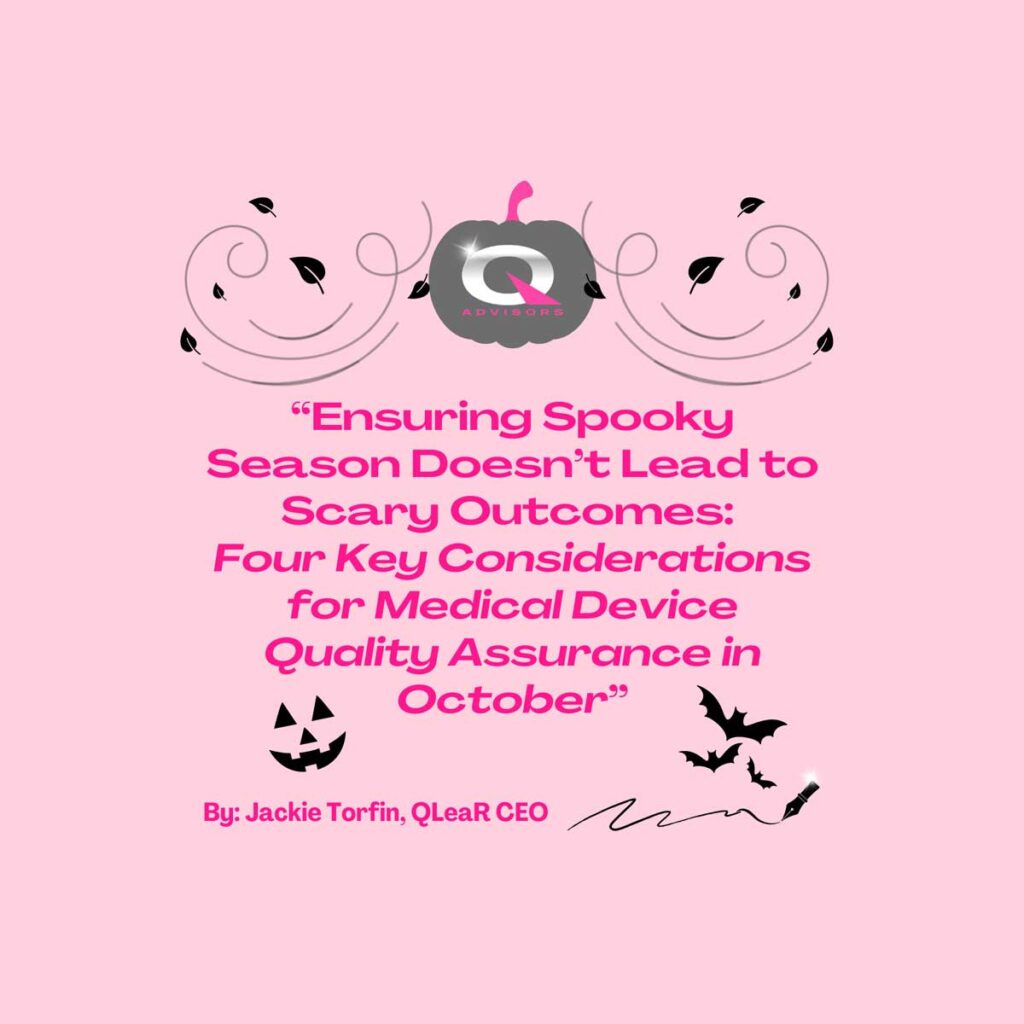Four Key Considerations for Medical Device Quality Assurance in October
As October ushers in the festive spirit of Halloween, with costumes, candy, and chilling thrills, this spooky season shouldn’t seep into the world of medical device quality assurance (QA). While the season’s theme embraces all things frightful, no one wants their medical devices to be part of any unexpected horror story.
1. The Seasonal Surge: Increased Demand and Production
The healthcare sector often sees a spike in patient care during the fall and winter months. Hospitals and clinics stock up on medical devices and supplies to handle the influx of patients, especially as respiratory illnesses and other seasonal ailments rise. To maintain high standards, several practices should be prioritized during the increased production season:
- Functional Testing: Ensure that all devices are subjected to rigorous functional testing under real-world conditions. October is no exception when it comes to maintaining thorough test protocols.
- Validation and Verification: Your design and development validation processes need to be watertight. Regularly review protocols for both verification and validation to guarantee that the device performs its intended function safely and effectively.
- Final Inspections: Implement final quality checks before shipping any product. Any flaws or inconsistencies should be identified before the device leaves the facility, not when it reaches the user.
Key Tip: Anticipate the seasonal spike and plan QA procedures accordingly. Forecasting demand helps prevent quality from taking a backseat to quantity.
2. Beware of Cyber Gremlins: Cybersecurity for Medical Devices
Medical devices have become increasingly connected to the internet and healthcare networks, making them vulnerable to cybersecurity threats. A lack of adequate protection can lead to unauthorized access to device data or, worse, tampering with the device’s functionality.
As Halloween brings with it stories of haunted devices and eerie happenings, cybersecurity risks in medical devices are not to be taken lightly. It’s essential to regularly update software and firmware, run vulnerability scans, and ensure that devices are protected by strong encryption protocols.
- Regular Updates: Ensure that all software and firmware are regularly updated to patch vulnerabilities and enhance security measures. Outdated systems are prime targets for cyberattacks.
- Vulnerability Scanning: Conduct routine vulnerability scans to identify potential weaknesses in device software or network configurations. Address any identified risks promptly to prevent exploitation.
- Encryption Protocols: Implement strong encryption protocols for data stored on and transmitted by the device. This helps protect sensitive patient data from unauthorized access.
- Access Control: Limit access to the device and its systems through robust authentication methods. Role-based access and two-factor authentication can help prevent unauthorized users from tampering with the device.
- Incident Response Plan: Establish a clear incident response plan that outlines steps to take in the event of a cyber breach. This plan should include data recovery, device shutdown protocols, and communication with stakeholders.
Key Tip: By maintaining vigilant cybersecurity practices, you can prevent your medical devices from becoming the source of a real-life nightmare. Strengthen cybersecurity measures for connected devices and incorporate security testing into the QA process. Partner with cybersecurity experts to ensure devices meet the highest standards of protection.
3. Supply Chain Management: Keeping It Strong
As companies accelerate production towards the end of the year, supply chain bottlenecks can become a significant challenge. Managing your suppliers and external partners carefully is essential to maintaining quality in October and beyond.
- Supplier Audits: Conduct supplier audits to verify that raw materials or outsourced components meet quality and regulatory standards.
- Vendor Qualification: Make sure your vendors are qualified and compliant with your quality management system (QMS).
- Contingency Planning: Anticipate potential delays or shortages and have contingency plans in place to ensure that critical components or materials don’t derail your production schedule or affect device quality.
Key Tip: Stay proactive in managing your supply chain by conducting regular supplier audits and ensuring vendors meet your quality standards. Having contingency plans in place will help prevent unexpected disruptions from compromising production timelines or device quality.
4. Creeping Risks: Proactive Risk Management
Every medical device carries some level of risk. October, with its spooky vibes, is a fitting time to revisit your risk management protocols to ensure no hidden dangers lurk within your devices. Risk management in QA involves identifying potential risks, assessing their likelihood and impact, and implementing mitigation strategies. Whether it’s mechanical failure, software bugs, or user errors, anticipating potential problems can prevent serious issues down the line.
- Revisit your Risk Management Plan (RMP): October is a good time to review RMPs to ensure they’re up-to-date and capable of identifying emerging risks.
- Failure Mode and Effects Analysis (FMEA): Ensure that your FMEA processes are stringent, regularly updated, and applied across the entire product lifecycle.
Key Tip: Use tools like Failure Mode and Effects Analysis (FMEA) to identify and mitigate risks early in the process. Make sure your team remains vigilant about monitoring and addressing emerging risks.
Conclusion: Keeping Spooky Season Safe
While October is a time for haunted houses and ghost stories, the medical device industry needs to maintain a different focus. With increased production, cybersecurity risks, and supply chain issues, it’s essential to remain vigilant and proactive.
By reinforcing your QA efforts and addressing these key considerations, your medical devices can sail smoothly through the spooky season without a scare in sight—keeping both patients and your bottom line safe from harm.

